
Note to any family reading this with a loved one who has contracted COVID-19: I write this with the utmost respect and fervent hope for your patient’s full recovery and your continued good health.
In these tense times wrought by the coronavirus, we are all in knots. But when I get a call from one of my grownup kids, I can feel myself relax. When we gathered from six cities to celebrate my son’s birthday in a Zoom call, he said it was his most meaningful in years.
Our technology keeps alive connections we’ve lost in the physical space and lifts the pall of loneliness. Digital media delights, entertains, and distracts us—and our children.
Yet, when the NewYork Times parenting newsletter tells us “Just Give Them the Screens (For Now),” we have to wonder: How long is Now? 15 days? 2 months? Until school begins next fall?
Before this crisis, people would lament, “I can’t get any busier!” or “Why is everything ramping up?” Kids’ refrains were related. “I can never get my mom’s attention” and “All my dad cares about is his phone.”
The last thing we should be is more unavailable. Yet, even we adults need nurturing and support.
So, what’s a parent to do?
Look for Opportunity
At this point, we can’t control much—except our own
attitudes.
Could it be a gift we can’t live at warp speed? Can we rejoice to be able to focus on, in the words of former Notre Dame football coach Lou Holtz, “What’s Important Now”?
When you think about it, to be stuck at home is a good thing. Our To-Do lists are way shorter. We don’t need to save gas by combining the errands we aren’t supposed to take. Our bosses, distracted by their own troubles, don’t crack the whip as hard. Our nights are neither FOMO nor Go Go Go, since no one’s Going anywhere.
It’s an opportunity to catch our collective breath, get more sleep, and see the people we talk to.
For too long, we’ve been in a state of continuous partial attention. Even when someone standing in front of us was crying, we’d keep one eye on our phones.
But now confined with our closest relatives, we have the chance not only to see them, we can hear and hug them, too—which is what they want and need.
If our kids’ school says “We couldn’t prepare for this, so please stand by ‘til we figure this out,” we can say “Hallelujah”!
In this bio-equivalent of 9-11, many kids’ minds are in crisis mode anyway, so absorbing new information is near impossible. Finally, kids can step off the activity wheel and actually Do Nothing.
But Nothing does not equate to staring at YouTube. For durable physical and brain development, kids need 3-D 360-degree movement using all their senses, not just those needed to operate a game controller or swipe across a screen.
Breeze and sunshine will soothe their souls, so take walks every day and let them play outside as much as possible. Sticks and mud can keep them amused for hours.
Most parks are closed, but there are no gates to prevent you from exploring many public spaces.
When they’re home, kids can amuse themselves with manipulative, free-form materials like Legos, crayons, and paper; and by playing games like hide and seek which get them up and moving.
Don’t worry he’ll fall behind as he lollygags in his makeshift tent of sheets. No one’s getting ahead with tests derailed, games cancelled, and plays unstaged.
Teach Your Children Well
If schoolwork is assigned, carpe diem instead of panic.
You were your kids’ first teacher, so relish returning to
the task. Why settle for rote worksheets and mind-numbing math apps? You can do better!
At their thoughtful mom’s direction, 6-year-old Ruthie and 10-year-old Callum call grandma and ask her about big things that have happened in her life. Then they write about and illustrates that piece of family history.
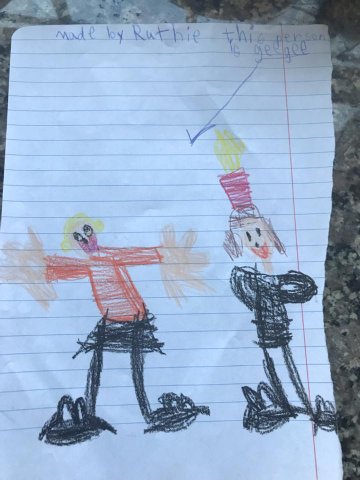
Pictured: Gee Gee (Ruthie’s grandmother) and Queen Elizabeth

Learning can happen anywhere in countless ways.
Figuring out how many eggs the family will eat for breakfast is real-life multiplication. Beating those eggs builds small motor skills and watching the liquid solidify is a science lesson. Plus, they learn what they can’t in a “regular” classroom: the needed life skill of cooking.
Author Audrey Monke has a 5-page “Ready for Adulthood” checklist in the back of her Happy Camper: 9 Summer Camp Secrets for Raising Kids Who Become Thriving Adults.
Some kids can tackle even on full home lockdown:
- Making a to-do list (they can write out their own daily plan)
- Sewing on a button (also builds small muscle control for jobs such as surgery)
- Managing their earnings from doing chores (See the Greenlight kid money management platform.)
Chores turn kids’ focus away from themselves and instill a priceless
sense of purpose borne of contributing to the greater good of the household.
Without commutes and typical schedules, the day will feel much longer. You can do stuff that somehow slid off the radar, like reading a book out loud before they go to bed. Here are some great ones.
Speaking of sleep, what about catching up on the chronic lack thereof? Teens are supposed to get somewhere around 9 hours, but during normal times only fifteen percent actually do. Resynchronizing with the Circadian Rhythm can only be a good thing for us human animals.
Start Good Household Habits
What if the whole house commits to keeping gadgets out of bedrooms at night? That way everyone (not just phones) will be recharged in the morning. Wonder how to do that? Dust off those trusty alarm clocks and feed cellphone rookies some Phone Food.
Master even more good tech hygiene habits together by taking The Durable Family Pledge.
Wait a minute, I hear you say. This will make my family freak out.
Well, you don’t have to just spring it on them. Call a family meeting where you can set expectations by explaining your thoughts to everyone at once, then they can give their opinions.
To keep the peace, you can bring along what indigenous peoples have long used to facilitate civil discussions: a Talking Stick. The stick is passed around from person to person, but only the person holding the stick may talk. Kids learn patience while waiting their turn and are delighted to have their voices heard.
But you don’t have to buy a fancy stick like mine.
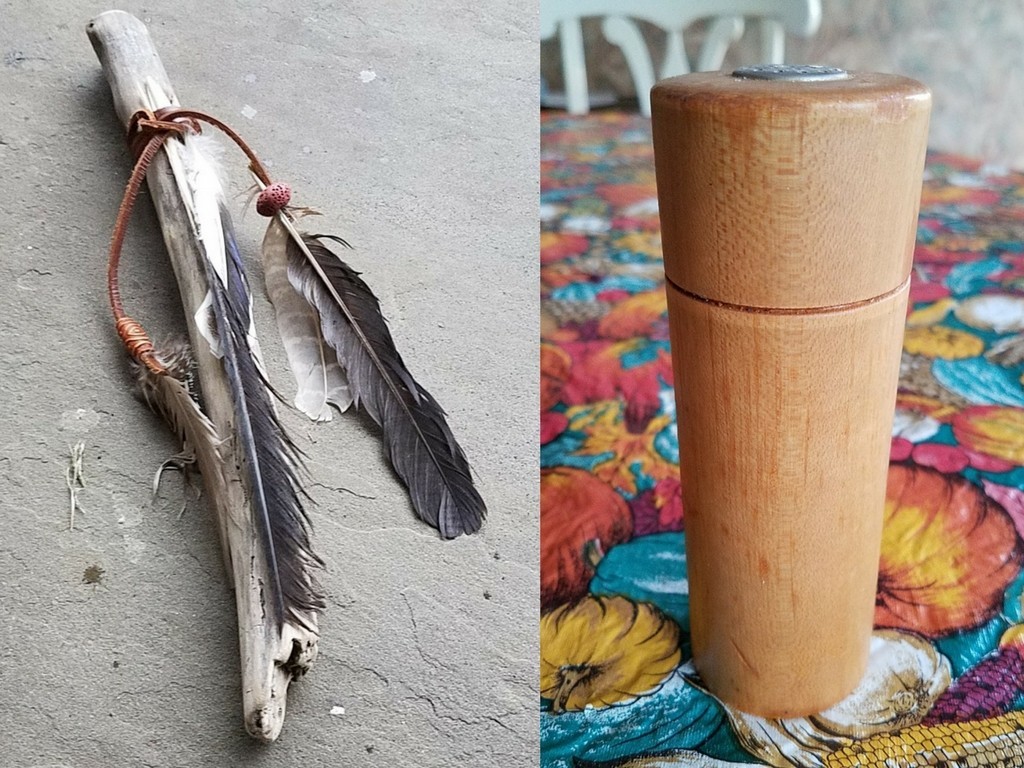
You can designate a simple hand-held household object like a salt shaker or ketchup bottle to serve the same function.
So, as we sail further into the New Normal, it’s not really about whether to leave kids to their own devices. It’s about seizing opportunities for love, fun, and learning during each precious dwindling day in the Time of Coronavirus.

About the author:
Jenifer Joy Madden is a health journalist, digital media adjunct professor, TEDx speaker, founder of DurableHuman.com, and parent of three self-reliant durable young adults. Jenifer’s words have appeared on news outlets ranging from ABC News to The Washington Post to Discovery Health Channel. She’s written two life- and tech-balance advice books, has a line of Durable Human products, and hosts the parent ed classroom, Durable U.
Find Jenifer’s books on Amazon and Audible: The Durable Human Manifesto: Practical Wisdom for Living and Parenting in the Digital World and How to Be a Durable Human: Revive and Thrive in the Digital Age Through the Power of Self-Design.
Download a free PDF of The Durable Human Manifesto here.

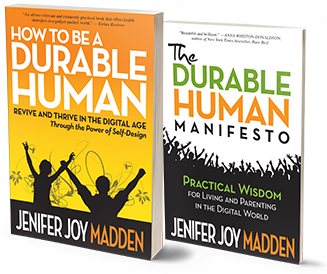
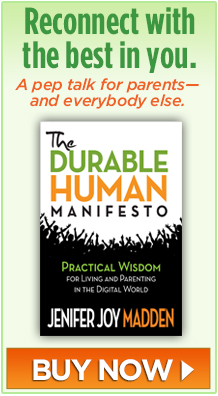
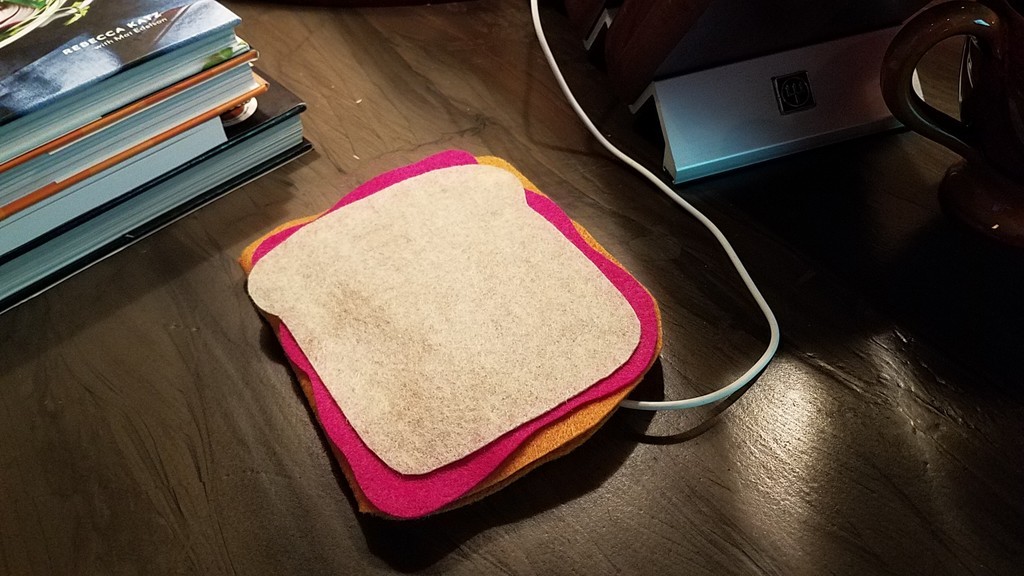

I’m so very glad you wrote about this time and talked about how this situation of disconnect from school and jobs can be used to reconnect with our immediate families.
Our children’s reactions our built on how we show them we perceive a situation. If we grasp hold of this with proper caution and yet not undue anxiety…we will help this future generation and ourselves navigate this in the best health possible just like others did before us in some of the worst times in our nation’s past. We can see and experience some of the true beauty that comes from this COVID-19 situation that Jennifer Joy Madden speaks of….a time to reconnect with each other and what matters most.
A time where we may have more time to build essential relationships to bonding, development and learning and more time ourselves to shape our children’s young neuroplastic brain’s which are built off of our own and what we “feed” them.
I have helped my children navigate this time by referring to this as “physical distance” (not my own term) instead of “social distance” as we are ALL social beings.
Let’s FaceTime our friends and connect in a positive way to use technology to stay connected face to face but not physically during this time. Also, using meal time as literature time for all your children can be a positive way to connect through conversation about the book’s content.
Right now my kids and I are reading “Number of the Stars” by Lois Lowry and my children are 8, 10, 12. My youngest has a whole new interest about WWII and is FaceTiming his grandparents asking whether their parent’s served in WWII and what they remember of their great grandparents’ talk of this time. We are also talking to our Jewish friends about how this affected their family’s ancestors and utilizing our 1984 encyclopedia set to learn how to look up the topic of World War II and the Holocaust as we learn together of other times where daily life was changed and people made sacrifices that were much greater than what we are “personally” experiencing in our own family now.
Other learning opportunities will come out of this situation and how measures were taken in the past…yes, this teacher/researcher momma had an in-depth talk with her kiddo’s in the car about “The Black Death Plague” and how it affected those living in the Middle Ages while my oldest son used my phone to fill in appropriate content and questions we all had during and after the discussion On our long drive home from seeing their grandparents physically for the last time in the next 8 weeks. These experiences provide for higher level learning…synthesis, evaluation, and discussion with those little ones you love so much, which empowers them with a deeper relationship with you as well as examples of GRIT and perseverance to create that “Durable Human” Madden so desperately helps us to assist our children to be. How are you utilizing this opportunity to be more durable. As a parent and teacher…I think we all need to be talking…I need some more ideas too…what are you doing during these “unchartered” times with your family? Looking forward to your ideas and suggestions…us mommas could use them!
Thank for your thoughtful comments and to see how thoughtfully you are approaching this unprecedented situation. I am happy to be a repository for goods ideas! Please keep them coming, Lori and readers!